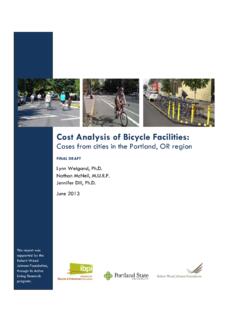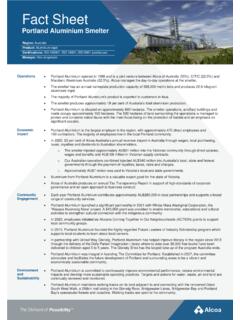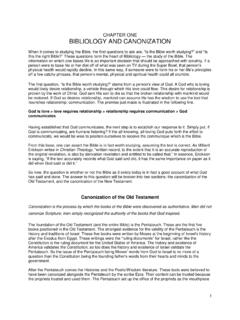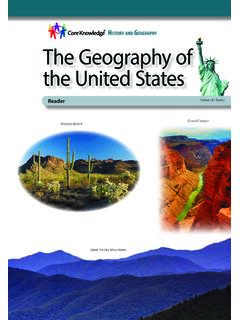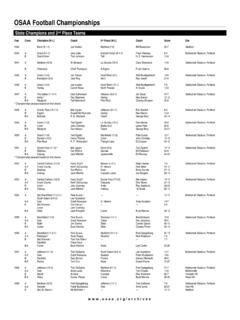Transcription of Guide to Cement-Treated Base (CTB)
1 By Gregory E. Halsted, David R. Luhr, Wayne S. Adaska Guide to Cement-Treated base (CTB) Guide to Cement-Treated base (CTB)Portland cement Association5420 Old Orchard RoadSkokie, Illinois Fax : Cement-Treated base (CTB) is a mixed-in-place or central-plant-produced material consisting ofsoil/aggregate, cement , and water that creates a strong and durable stabilized roadway base . This Guide toCTB discusses its applications, benefits, design, construction, testing, and : Cement-Treated base , CTB, pavement, subgrade, soil/aggregate, pavement structure, portlandcement, pavement design, mixed-in-place, pugmill, moisture-density relationship, compressive strength, mixdesign, Tube Suction Test, processing, scarification, pre-wetting, reflective cracking, :Halsted, Gregory, E.
2 ; Luhr, David, R.; Adaska, Wayne, S., Guide to Cement-Treated base (CTB),EB236 Portland cement Association, Skokie, Illinois, USA, 2006, 20 the Authors:Gregory E. Halsted, , Pavements Engineer, Portland cement Association, PostOffice Box 5113, Bellingham, Washington 98227-5113, R. Luhr, PhD, , Program Manager, Portland cement Association, Post Office Box 5895, Cary, NorthCarolina 27511, S. Adaska, , Director of Public Works, Portland cement Association, 5420 Old Orchard Road,Skokie, Illinois 60077-1083, :Contact with wet (unhardened) concrete,mortar, cement , or cement mixtures can cause SKIN IRRITA-TION, SEVERE CHEMICAL BURNS (THIRD DEGREE), or SERI-OUS EYE DAMAGE.
3 Frequent exposure may be associatedwith irritant and/or allergic contact dermatitis. Wear water-proof gloves, a long-sleeved shirt, full-length trousers, andproper eye protection when working with these materials. Ifyou have to stand in wet concrete, use waterproof bootsthat are high enough to keep concrete from flowing intothem. Wash wet concrete, mortar, cement , or cementmixtures from your skin immediately. Flush eyes with cleanwater immediately after contact. Indirect contact throughclothing can be as serious as direct contact, so promptlyrinse out wet concrete, mortar, cement , or cement mixturesfrom clothing.
4 Seek immediate medical attention if youhave persistent or severe cement Association ( PCA ) is a not-for-profit organization and provides this publicationsolely for the continuing education of qualified professionals. THIS PUBLICATION SHOULD ONLY BEUSED BY QUALIFIED PROFESSIONALS who possess all required license(s), who are competent to eval-uate the significance and limitations of the information provided herein, and who accept totalresponsibility for the application of this information. OTHER READERS SHOULD OBTAIN ASSISTANCEFROM A QUALIFIED PROFESSIONAL BEFORE PROCEEDING.
5 PCA AND ITS MEMBERS MAKE NO EXPRESS OR IMPLIED WARRANTY WITH RESPECT TO THIS PUBLI-CATION OR ANY INFORMATION CONTAINED HEREIN. IN PARTICULAR, NO WARRANTY IS MADE OFMERCHANTABILITY OR FITNESS FOR A PARTICULAR PURPOSE. PCA AND ITS MEMBERS DISCLAIMANY PRODUCT LIABILITY (INCLUDING WITHOUT LIMITATION ANY STRICT LIABILITY IN TORT) INCONNECTION WITH THIS PUBLICATION OR ANY INFORMATION CONTAINED photo:Plant-mixed CTBproject in South Georgia. Courtesy ofMr. Dwane Lewis, Technical ServicesManager, Georgia Department ofTransportation. (IMG24044)Print HistoryFirst Printing 2006 2006 Portland cement AssociationISBN 0-89312-253-XAll rights reserved.
6 No part of thisbook may be reproduced in any formwithout permission in writing fromthe publisher, except by a reviewerwho wishes to quote brief passagesin a review written for inclusion in amagazine or to Cement-Treated base (CTB)iiiTable of Contents1 Introduction.. 1 Definition .. 1 Performance with CTB .. 12 Design.. 5 Material Requirements .. 5 Pavement Design .. 6 Mix Design .. 6 Balanced Design .. 7 Moisture Sensitivity .. 83 Construction.. 9 General Requirements.. 9 Mixed-In-Place Method .. 10 Central-Plant Method .. 11 Compaction, Finish, and Cure .. 12 Surfacing.
7 13 Reflective Cracking .. 134 Suggested Construction Specification for Cement-Treated base .. 15ivGuide to Cement-Treated base (CTB)11 IntroductionDefinitionCement- treated base (CTB) is a general term that applies toan intimate mixture of native soils and/or manufacturedaggregates with measured amounts of portland cement andwater that hardens after compaction and curing to form astrong, durable, frost resistant paving material. Otherdescriptions such as soil- cement base , Cement-Treated aggre-gate base , cement -stabilized roadbed, and cement -stabilizedbase are sometimes can be mixed in place using on-site materials, or mixedin a central plant using selected material (often manufacturedaggregates).
8 Mixed-in-place CTB is compacted after blend-ing, and CTB mixed in a central plant is hauled to the place-ment area in dump trucks and placed on the roadway usinga grader, paver, or Jersey-type spreader. A bituminous wear-ing course or portland cement concrete is placed on top ofthe CTB to complete the with CTBW hile the concept of stabilizing soils and aggregates forpavement purposes has been around for more than a century,engineered CTB was first used in 1935 to improve the road-bed for State Highway 41 near Johnsonville, South , thousands of miles of CTB pavements in every state inthe United States and in all the Canadian provinces are pro-viding good service at low maintenance is widely used as a pavement base for highways, roads,streets, parking areas.
9 Airports, industrial facilities, and mate-rials handling and storage areas. The structural propertiesof CTB depend on the soil/aggregate material, quantity ofcement, curing conditions, and age. Typical properties ofCTB material are shown in Table advantages of CTB are many: CTB provides a stiffer and stronger base than an unboundgranular base . A stiffer base reduces deflections due totraffic loads, which results in lower strains in the asphaltsurface. This delays the onset of surface distress, suchas fatigue cracking, and extends pavement life (seeFigure ). CTB thicknesses are less than those required for granularbases carrying the same traffic because the loads aredistributed over a large area (see Figure ).
10 The stronguniform support provided by CTB results in reducedstresses applied to the subgrade. A thinner cement -stabilized section can reduce subgrade stresses more thana thicker layer of untreated aggregate base . Subgradefailures, potholes, and road roughness are thus s slab-like characteristics and beam strength areunmatched by granular bases that can fail when interlockis lost. Figure is a core of completed CTB showing thetightly bound soil/aggregate. A wide variety of in-situ soils and manufactured aggre-gates can be used for CTB. This eliminates the need tohaul in expensive select granular 1.
